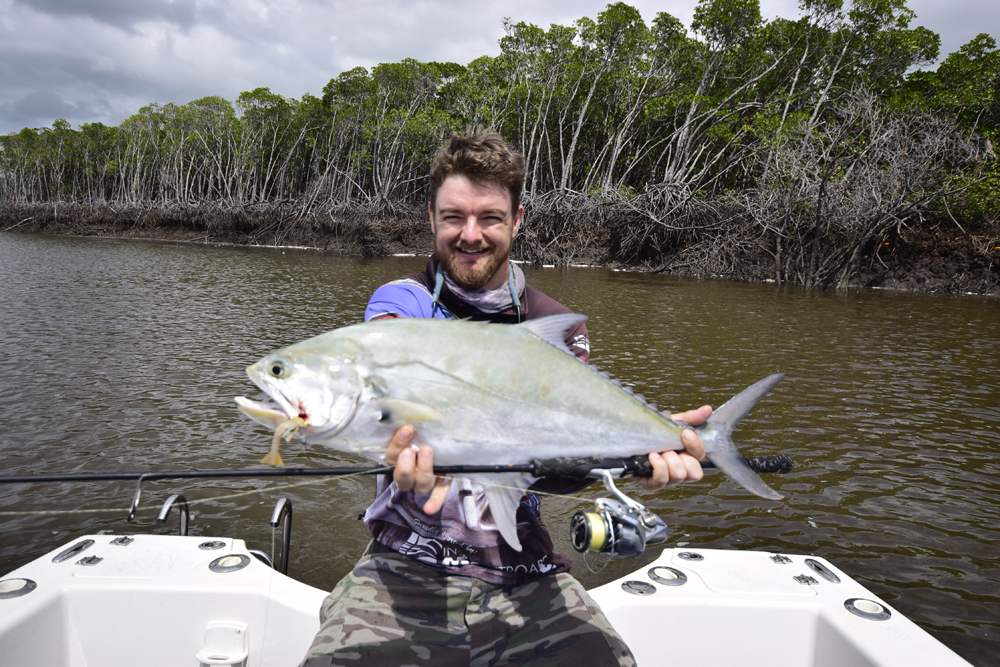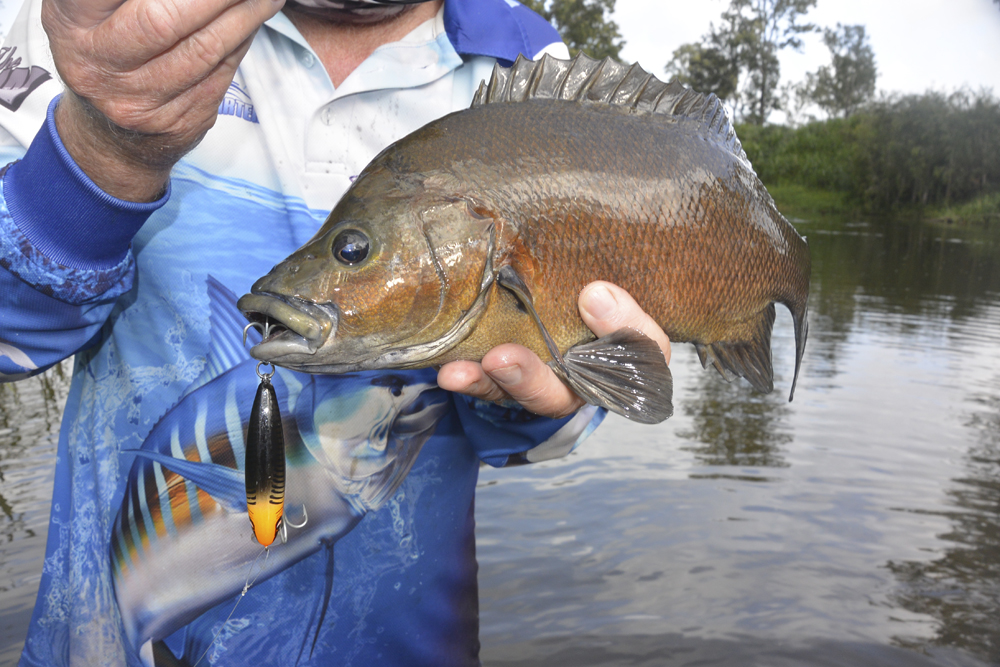Goldilocks and the Three Snags – By Lee Brake
It’s amazing the parallels you draw. As a fisherman and a father to a two-year-old, I found myself pondering the children’s classic Goldilocks and the Three Bears this week, a book I often read to my daughter.
The book really resonated with me during a desperate attempt to scratch my fishing itch after weeks of 20knot-plus winds and rain. The old man and I decided to put on some walking shoes, grab the light gear and foot falcon our way up the sweet water of the Pioneer River. Our target was the football-shaped, mean-spirited sooty grunter.
Now, you may ask what a blonde with a penchant for breaking and entering and sooty grunter fishing have in common. Well, as I am finally starting to learn, when it comes to finding snag-dwelling predators, it pays to be fussy.
When we first arrived at a nice stretch of river, we quickly zeroed in on a few likely-looking spots. Based on past experience, we had an ingredient list we were looking for – we wanted structure that dissected the current and created an ambush point; we wanted that structure to be in deep water, and, ideally, we wanted it to be in the shade and within casting distance. It needed to be “just right”…

We found a few spots that were about right, the first spot was a fallen tree at the base of a narrow section of rapids, and while it looked great, it had too much water cascading directly onto it. The poor sooties would have had to work too hard against the current. The run was too strong.
The second spot was also pretty good. It was a much bigger log, in full shade, but this one had reeds and lilies growing around it and was in a bit of a backwater out of the run. The main current was running through the centre of the river at that point and was well away from the log. The run was too weak.
So, like that fairy-tale petty criminal, we’d embarked on an adventure of trial and error but were yet to find the sweet spot. Luckily enough, it came around the next bend, but what followed shows just how fickle fishing fortunes can be.
We both liked the look of a fallen tree sitting a few metres off the bank that was lying in around two metres of water. It had a main trunk and two significant branches, which meant three parallel pieces of submerged structure, and it was just behind a section of bank that jutted out into the main current. That protruding section of bank took the sting out of the running water so that by the time it reached the snag it wasn’t rushing and bubbling – it was merely flowing. In short, not too strong, not too weak – just right.

That left two ingredients – shade and reachable casting distance. Thankfully we had shade because it was early morning and a big cloud was over the sun. Casting distance, on the other hand, was lacking. From the point where we had waded out to just past our knees, our casts were coming up about a metre short of the centre trunk. They were landing near the outside branch, but not close enough. I was working a little thumb-size popper, so I hoped that after a dozen casts something would be annoyed enough to swim out for a look. Nothing did, so finally I took the plunge – literally. I waded out a little further to that point of no return where water-inundation of the underpants ensued. Some parts of the body really do feel the cold more than others, eh!
Anyway, wading forward a metre meant I gained a metre on my casts, and that’s all it took. The little popper actually landed over the centre trunk, which was exposed just enough to be a potential sticking point. Luckily, the popper hopped over, and after two little pops right in the strike zone the water exploded, and a black back appeared amongst a spray of white-water. But, as so often happens when you feel like you’ve finally got things just right – the bears come home and spoil everything. Well, in this case, the little sooty bear busted a frayed section of my 10lb braid and stole my popper, but you get the picture.

Luckily though, as I re-rigged, my popper was avenged. The old man also took the plunge and got close enough to land his shallow Reidy’s Little Lucifer in the strike zone. One twitch was all it took, and he was on. It wasn’t a big sooty – maybe 30cm – but gee it had some poke. There were a few moments where he was at risk of being rubbed off in the timber before the feisty fish finally came out of the danger zone. After a quick piccy, the sooty was returned, and I was back in action with another popper. Sure enough, I got smacked again. A smaller fish this time, but it almost got fully airborne during the strike, so I was impressed. Unfortunately, in its overzealous attack, it missed the hooks.
And then we lost an ingredient. The sun burst from behind the cloud like an avenging angel. The snag was lit up by a harsh overhead glow and without any overhanging vegetation to shield it, the bite dried up. Maybe if I’d have swapped to a weighted spinnerbait, vibe or plastic, I might have tempted another take from a fish holding down deeper, but a coffee was calling, so we pulled the pin.
That little morning session really got me thinking about what the most important ingredient was when snag fishing. Did everything have to be “just right” or was there some leeway? And if there was, what ingredients did you have a little bit of wiggle room with?
I have a few theories.
My last really red-hot snag-bashing trip was a two-day Hinchinbrook run before Christmas, and while we were fishing tidal saltwater creeks for jacks, most of the above ingredients are still applicable. And on this trip, we caught enough fish to crack a pattern and learn some important lessons.
Both jacks and sooties love to lurk in the shade – jacks love an undercut bank with mangrove rhizomes and branches providing aerial cover. Both prefer deeper bends, gulley’s and holes, and both like their structure to be as gnarly and dense as the cast of a Jackass movie.
Just like on our sooty session, all of those things counted for naught when there wasn’t water movement. Without the right tidal influence or running drain pushing onto a spot, we were wasting our time.
So, I’ll go out on a limb here and say that the number one ingredient that must be just right is water movement. The current is what brings the bait to the ambush point, so if that’s not just right, then the predators will likely be somewhere else where it is.

I’m going to theorise that the second most important ingredient is depth and cover/shade – you need at least one, and if you have to pick one, I’d say depth. A shallow edge in deep shade is still worth a cast, as I have seen jacks, cod and even barra sit in the smallest crack or divot in mud, as long as they are in the shade. However, these fish are easy to spook, so try casting up-water from them and bringing your offering past them, rather than landing on their heads.
Deeper edges are better, as they give the fish an easier escape option if threatened. Most predatory fish naturally feed upwards in the water column too, so they can sit down in the shadowy depths and feed on anything moving above.
Based on this, the least important ingredient is actually the structure. If you’ve got water movement and shelter from either depth or shade, then there’s enough to hold fish.
Add structure into that equation, and you have a multiplier effect. For example, a single mangrove rhizome hanging into a deep, undercut corner with a nice current pushing onto it will often have a single jack or barra sitting with its nose behind it. Turn that single rhizome into a fallen mangrove limb with some green leaves, and a small school of three or four fish might take a residence. Turn that limb into a whole fallen mangrove tree with a trunk and multiple branches, and you suddenly have a full ecosystem. A spot like that is just right and might easily hold enough fish to keep you busy for a whole session – or until you get busted off or snagged up.
The moral of the story? Experimentation is important, but don’t waste too much time on it – a bed/chair/porridge/snag pile might look perfect, but if it isn’t quite right, move on. Really start looking at what’s in front of you. Tick the ingredients off in your head and read the water. Fish three spots that tick all the boxes and are “just right”, and I guarantee you will catch more fish than trying 30 spots that are a bit off.
And remember, once you find that spot that’s just right hold on, because then it’s time to deal with the bears, so you better have come prepared!





